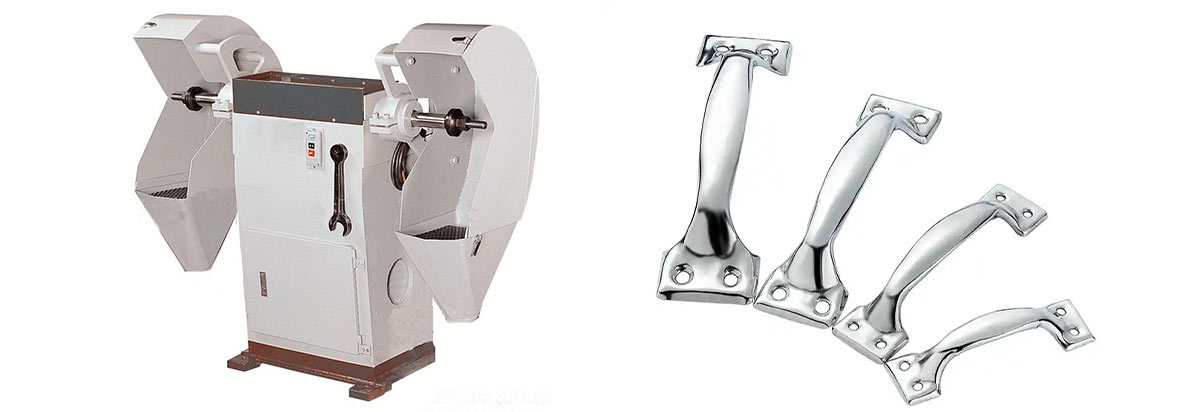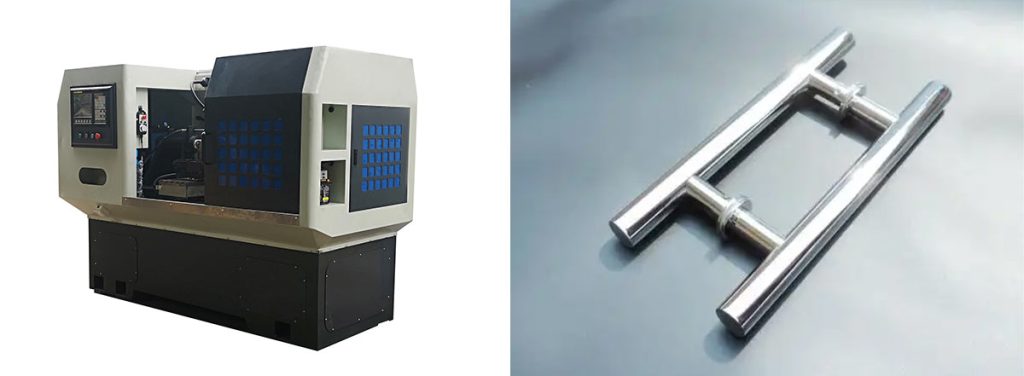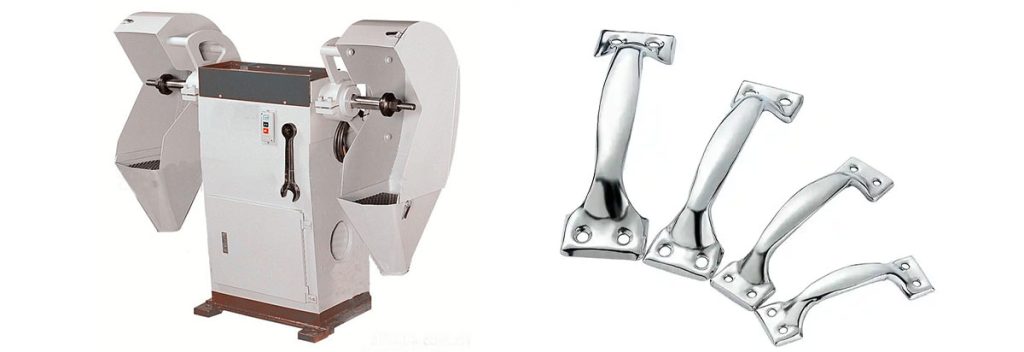

Metal parts polishing plays a vital role in meeting industry surface quality standards. This process enhances the durability and performance of metal parts by eliminating surface defects and creating a smooth finish. Polished surfaces resist corrosion more effectively, ensuring longevity even under extreme conditions. Additionally, they reduce friction, improving operational efficiency and lowering energy consumption.
Polishing also improves aesthetics. A polished metal part exudes quality and craftsmanship, making it more appealing to consumers. The smooth finish simplifies cleaning and maintenance, which is essential in industries requiring strict hygiene standards, such as food processing and healthcare.
Key Takeaways
- Polishing metal parts makes them last longer and work better. It creates smooth surfaces that stop rust and lower friction.
- Knowing surface quality rules is very important. These rules decide how smooth metal parts should be to work well and look good.
- Methods like buffing, grinding, and electrochemical polishing help make the right surface finish and meet industry rules.
- Taking care of polishing tools and training workers is key. This ensures good results and smooth finishes every time.
- Using better polishing tools and methods can make products better, save money over time, and follow industry rules.
Understanding Industry Surface Quality Standards
Defining Surface Quality Standards
Surface quality standards define the acceptable level of surface finish for metal parts in various industries. These standards ensure that the surface roughness, texture, and appearance meet the functional and aesthetic requirements of the application. Surface finish standards vary depending on the industry and the intended use of the part. For example, aerospace components demand extremely smooth finishes to reduce drag, while medical devices require surfaces that are easy to sterilize.
Surface roughness, a key parameter in these standards, measures the irregularities on a metal surface. Lower roughness values indicate smoother finishes, which are often essential for achieving high standards of surface finish. By adhering to these standards, manufacturers can ensure consistency, reliability, and performance in their products.
Importance of Surface Finish in Metal Parts
The surface finish of metal parts directly impacts their performance, durability, and appearance. A smoother finish minimizes surface roughness, reducing the risk of corrosion by eliminating crevices where moisture can accumulate. This enhances the lifespan of metal parts, especially those exposed to harsh environments.
- Surface finishing improves wear resistance, making parts more durable under mechanical stress.
- Polished surfaces reduce friction, which is crucial for moving parts in machinery.
- High-quality finishes enhance conductivity in electrical components, improving their efficiency.
In addition to functionality, surface finish plays a significant role in aesthetics. A polished metal surface conveys a sense of quality and precision, which is vital in consumer-facing products. Proper finishes also simplify cleaning and maintenance, making them indispensable in industries like healthcare and food processing.
Applications Requiring High-Quality Surface Finish
Many industries rely on high standards of surface finish to meet their operational and regulatory requirements. In aerospace, smooth metal surface finishes reduce drag and improve fuel efficiency. The medical field demands surfaces with minimal roughness to prevent bacterial growth and ensure sterility. Similarly, the automotive industry uses polished finishes to enhance both performance and visual appeal.
Industrial manufacturing processes often require metal parts with specific surface finish standards to ensure compatibility and functionality. For example, sliding components in machinery benefit from reduced friction, while outdoor equipment requires finishes that resist corrosion. High-quality finishes are also critical in electronics, where smooth surfaces improve conductivity and reduce energy loss.
The Role of Metal Parts Polishing in Achieving Standards
How Polishing Improves Surface Finish?
Polishing plays a crucial role in achieving the desired surface finish for metal parts. It reduces surface roughness by smoothing out irregularities, which enhances both functionality and appearance. Techniques like buffing, grinding, and electrochemical polishing are commonly used to achieve this. Buffing employs a soft cloth wheel and fine abrasive compounds to create a high-gloss finish, while grinding removes significant material to eliminate imperfections. Sanding refines the surface further, preparing it for final polishing.
Electrochemical polishing is another effective method. This process involves placing the metal part as an anode in an electrolytic solution. When an electric current passes through, the surface dissolves ionically, leveling microscopic peaks and filling valleys. The result is a bright, clean, and reflective surface that resists corrosion and improves cleanability. Polished surfaces also reduce adhesion, making them easier to maintain.
- Creates a shiny and smooth surface.
- Enhances appearance while preventing corrosion.
- Improves cleanability and reduces adhesion.
- Leaves a reflective and clean material surface.
| Technique | Description | Benefits |
|---|---|---|
| Buffing | Uses a soft cloth wheel and fine abrasive compound to produce a high-gloss finish. | Smooths out tiny imperfections and gives a brilliant shine. |
| Grinding | Employs a coarse abrasive wheel to remove substantial material. | Smooths out welds, removes burrs, and prepares surfaces for further finishing processes. |
| Sanding | Uses abrasive belts or discs to refine the metal surface after grinding. | Essential for smoothing out scratches and marks left by grinding. |
Compliance with Industry Standards Through Polishing
Metal parts polishing ensures compliance with strict industry standards. Surface finish standards dictate the acceptable levels of surface roughness and texture for various applications. Polishing processes help manufacturers meet these requirements by creating consistent and reliable finishes. For example, aerospace components require smooth surfaces to reduce drag, while medical devices demand finishes that prevent bacterial growth.
Polishing also supports regulatory compliance. Industries like food processing and pharmaceuticals rely on polished surfaces to maintain hygiene and sterility. By adhering to surface finish standards, manufacturers can enhance product quality and ensure safety in critical applications.
Industries That Depend on Metal Polishing

Several industries rely heavily on metal polishing service to meet their specific needs. The automotive sector uses polishing to improve both the performance and aesthetics of components. In the pharmaceutical and food industries, polished surfaces ensure cleanliness and prevent contamination. The marine industry depends on polishing to protect vessels from saltwater corrosion while enhancing their visual appeal.
| Industry | Specific Needs |
|---|---|
| Biochemical | Ensure equipment surfaces are free from contaminants and withstand chemical exposure. |
| Petrochemical | Remove surface imperfections to prevent corrosion and leaks, ensuring safety and reliability. |
| Marine | Protect vessels from saltwater corrosion and enhance visual appeal. |
| Automotive | Improve aesthetics and resistance to corrosion, enhancing performance of components. |
| Jewelry | Enhance beauty and value of precious metals, achieving smooth, reflective surfaces. |
| Pharmaceutical | Maintain cleanliness and sterility, producing passive surfaces that resist bacterial growth. |
| Food & Beverage | Ensure hygiene and ease of cleaning, preventing food particles and bacteria accumulation. |
| Aviation | Reduce aerodynamic drag and enhance fuel efficiency through smooth surfaces. |
| Architectural | Enhance aesthetic appeal and durability of metal components in buildings. |
| Trucking | Maintain durability and appearance of vehicle components, enhancing resistance to corrosion. |
Polishing processes, including the use of industrial metal polishing machine, play a vital role in these industries. They ensure that metal parts meet the required standards for performance, durability, and appearance.
Techniques and Tools for Metal Parts Polishing
Mechanical Polishing Methods
Abrasive Techniques
Mechanical polishing often begins with abrasive techniques to refine the surface of metal parts. This method uses abrasive materials like pads, belts, or wheels to remove imperfections and achieve a smoother surface finish. It is commonly applied to metals such as aluminum, brass, and stainless steel. Abrasive techniques can be performed manually or with industrial metal polishing machine, which enhance precision and efficiency.
- Abrasive techniques range from coarse grinding to fine polishing, depending on the desired finish.
- Careful handling is essential to avoid over-polishing, which can damage the surface.
| Method | Description | Application |
|---|---|---|
| Buffing | Uses a soft cloth wheel and fine abrasive to achieve a high-gloss finish. | Ideal for final finishing touches. |
| Grinding | Employs a coarse abrasive wheel to remove substantial material. | Used for smoothing welds and preparing surfaces. |
| Sanding | Utilizes abrasive belts or discs to refine the surface after grinding. | Essential for preparing metal for further refining. |
Buffing and Grinding
Buffing and grinding are integral to mechanical polishing. Buffing employs a soft wheel and fine abrasives to create a mirror-like finish. This technique is ideal for final touches, enhancing both the appearance and functionality of metal parts. Grinding, on the other hand, uses coarse abrasives to remove significant material, smoothing welds and eliminating surface defects. Together, these methods prepare the surface for further polishing processes.
Chemical Polishing Processes
Acid-Based Polishing
Chemical polishing involves using acid-based solutions to dissolve surface irregularities and achieve a uniform finish. This process is highly efficient for polishing complex-shaped workpieces and multiple parts simultaneously. It provides an ultraclean surface finish, improving both corrosion resistance and mechanical strength.
| Advantages of Chemical Polishing | Disadvantages of Chemical Polishing |
|---|---|
| Polishes complex-shaped workpieces | Inconsistent or uneven brightness |
| Affordable without specialized fixtures | Difficult to heat solution accurately |
| Highly efficient for multiple parts | Hard to adjust and regenerate solution |
| Provides ultraclean surface finish | Produces harmful gases |
Safety Measures in Chemical Polishing
Chemical polishing requires strict safety measures to protect workers and the environment. Personal protective equipment (PPE) such as gloves and goggles should always be used. Working in well-ventilated areas minimizes exposure to harmful fumes. Proper disposal of chemical waste prevents contamination of water sources and soil. Using biodegradable or non-toxic compounds can further reduce environmental impact.
Electro-Polishing Techniques
Process Overview
Electro-polishing refines the surface by removing high spots through an electrochemical process. The metal part acts as an anode in an electrolytic solution. When an electric current passes through, the surface dissolves ionically, creating a smooth and uniform finish. Unlike mechanical polishing, this technique eliminates embedded particles and directional lines, resulting in a bright, debris-free surface.
Electropolishing enhances aesthetics, corrosion resistance, and microfinish. It often improves surface roughness by up to 50%, making it ideal for applications requiring a flawless surface.
Benefits of Electro-Polishing
Electro-polishing offers unique advantages over other polishing techniques. It creates hygienic and biocompatible surfaces, essential for medical instruments and food industry equipment. The process also enhances corrosion resistance by forming a protective oxide layer on stainless steel. Additionally, it ensures easy cleaning and maintenance, making it a preferred choice for achieving a high-quality surface finish.
- Reduces bacterial growth on medical instruments.
- Ensures sanitary surfaces for food safety.
- Improves corrosion resistance and durability.
Selecting the Right Polishing Tools
Selecting the right tools for metal polishing is essential to achieve the desired surface quality. The choice of tools directly impacts the efficiency and outcome of the process. Several factors must be considered to ensure the tools align with the specific application:
- Material type and properties: Different metals, such as aluminum, stainless steel, or brass, require specific polishing techniques and tools to avoid damage or over-polishing.
- Part geometry and complexity: Intricate shapes or hard-to-reach areas may need specialized tools or attachments for effective polishing.
- Required surface finish and appearance: The desired level of smoothness or gloss determines whether abrasive, chemical, or electro-polishing techniques are suitable.
- Production volume and timeline: High-volume production may benefit from automated or industrial metal polishing machines to save time and maintain consistency.
- Available budget and equipment: Cost-effective solutions should balance quality and affordability without compromising the final surface finish.
- Environmental and safety regulations: Tools that comply with safety standards and minimize environmental impact are crucial for sustainable operations.
Advanced polishing tools offer significant long-term benefits for industrial applications. These tools often incorporate waste-recycling features, reducing landfill contributions. Smarter technologies optimize energy use, lowering operational costs over time. Many modern tools use biodegradable or recyclable abrasives, which lessen the environmental burden compared to traditional products. Water-efficient designs recycle water during the process, conserving resources and preventing contamination. Enhanced efficiency also reduces carbon emissions, making the polishing process more sustainable.
Industrial metal polishing machine equipped with these advanced features ensures not only superior surface finishes but also environmentally responsible operations. By carefully selecting the right tools, manufacturers can achieve consistent results while adhering to industry standards and sustainability goals.
Challenges and Best Practices in Metal Parts Polishing
Common Challenges in Achieving Surface Quality
Addressing Surface Defects
Surface defects often hinder achieving the desired surface finish in metal polishing. These defects include scratches, pits, and uneven textures, which can compromise both functionality and aesthetics. Regular visual inspections during the polishing process help identify these issues early. Tools like surface roughness gauges and gloss meters provide precise measurements, ensuring compliance with surface finish standards. Establishing clear quality control guidelines at each stage of the process minimizes errors and ensures consistent results.
Operators play a crucial role in addressing defects. Their feedback can highlight areas for improvement, such as optimizing cycle times or refining polishing techniques. Staying updated on advancements in polishing technologies and materials also enhances defect management, leading to better surface preparation and smoother finishes.
Material-Specific Considerations
Different materials present unique challenges during metal polishing. For instance, softer metals like aluminum are prone to over-polishing, while harder materials like stainless steel require more aggressive techniques. Selecting the appropriate polishing method based on the material’s properties is essential. Complex geometries further complicate the process, requiring specialized tools or industrial metal polishing machines to achieve uniform results.
Controlling polishing pressure and motion is another critical factor. Excessive pressure can damage the surface, while inconsistent motion leads to uneven finishes. Regular inspections and adjustments ensure the process aligns with the material’s requirements, maintaining the desired surface finish.
Best Practices for Consistent Polishing
Tool Maintenance and Care
Proper maintenance of polishing tools ensures consistent results. Worn-out tools can cause uneven surface roughness, compromising the finish. Regular cleaning and inspection of tools like abrasive belts, polishing mops, and brushes extend their lifespan and maintain efficiency. Replacing damaged components promptly prevents defects and ensures smooth operation.
Training in Polishing Techniques

Operator training is vital for achieving consistent surface finishes. Standardized training programs teach proper techniques, such as sequential use of polishes and controlling pressure. Skilled operators can adapt to different materials and geometries, ensuring uniform results across projects. Training also fosters a deeper understanding of surface finish standards, enhancing overall quality.
Tips for Achieving Optimal Results
- Degrease metal surfaces to remove oils and contaminants before polishing.
- Use acid pickling to eliminate rust and mill scale for a cleaner surface.
- Avoid polishing in a single direction to achieve uniformity.
- Maintain a low working speed to prevent overheating and damage.
- Implement robotic polishing systems for consistent pressure and motion control.
Tip: Use polishing compounds sparingly to avoid grease marks and ensure a mirror-like finish. Always inspect abrasive materials for wear to maintain effectiveness.
By following these practices and addressing challenges proactively, manufacturers can achieve flawless surface finishes that meet industry standards.
Conclusion
Metal parts polishing remains essential for meeting industry standards. It ensures a flawless finish, enhancing both the functionality and appearance of components. Polished surfaces reduce friction, resist corrosion, and improve durability, making them indispensable across industries. The table below summarizes the key benefits of polishing:
| Benefit | Description |
|---|---|
| Aesthetic Appeal | Polished metal surfaces are smooth and shiny, enhancing the visual quality of products in various industries. |
| Functional Performance | Polishing reduces friction and prevents dirt accumulation, crucial for moving parts in aerospace and automotive sectors. |
| Corrosion Resistance | Smoothing surfaces minimizes oxidation risks, extending the lifespan of components in harsh environments. |
| Increased Durability | A uniform finish prevents weak spots, ensuring components withstand extreme conditions without damage. |
Adhering to best practices in polishing further amplifies these advantages. Consistent techniques improve product durability, simplify maintenance, and ensure resistance to corrosion. The following table highlights these measurable benefits:
| Benefit | Description |
|---|---|
| Improved Product Durability | Polished surfaces enhance the longevity and durability of products by protecting against wear. |
| Resistance to Corrosion | Polished finishes minimize corrosion and oxidation, crucial for components in harsh environments. |
| Easier Maintenance | Smooth surfaces are easier to clean, preventing dirt accumulation and ensuring hygiene. |
By following these practices and utilizing tools like industrial metal polishing machine, manufacturers can achieve superior results. Consistency in polishing techniques ensures that every component meets the required standards, delivering optimal performance and aesthetic appeal.
Tip: Investing in advanced polishing tools and training operators can significantly improve the quality of the finish while reducing long-term costs.
